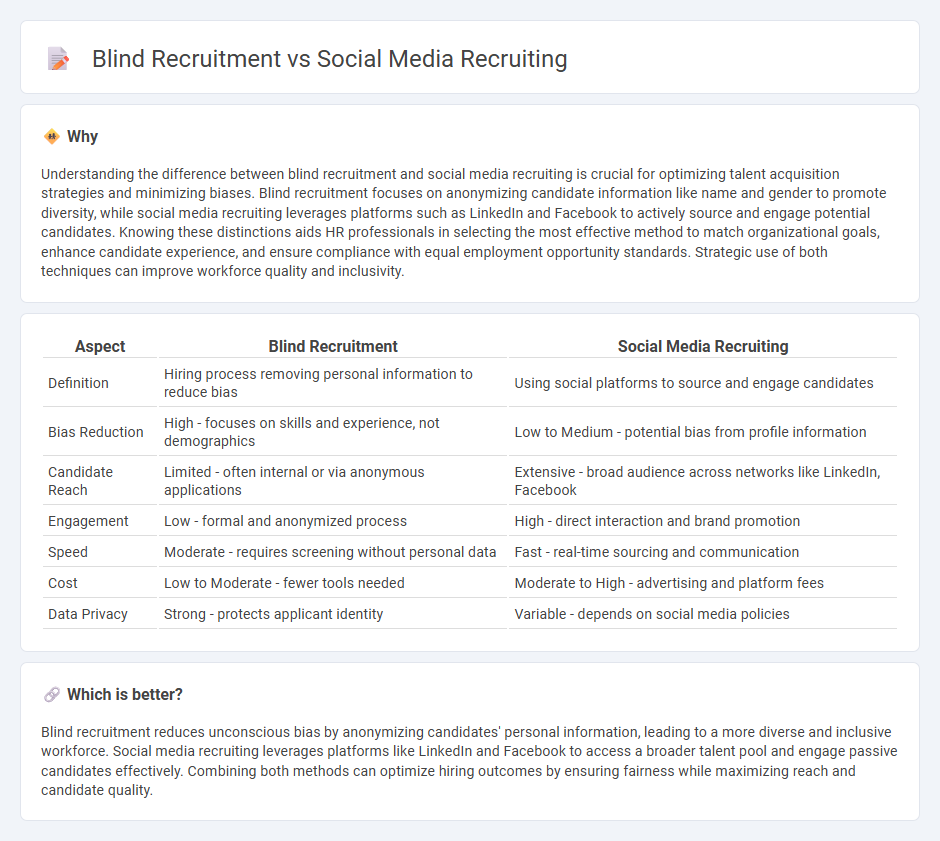
Blind recruitment focuses on eliminating unconscious bias by anonymizing candidate information such as names, gender, and educational background during the hiring process to promote diversity and inclusion. Social media recruiting leverages platforms like LinkedIn, Facebook, and Twitter to identify and engage potential candidates, enhancing reach and targeting specific skill sets efficiently. Explore the differences and benefits of these recruitment strategies to optimize your hiring process.
Why it is important
Understanding the difference between blind recruitment and social media recruiting is crucial for optimizing talent acquisition strategies and minimizing biases. Blind recruitment focuses on anonymizing candidate information like name and gender to promote diversity, while social media recruiting leverages platforms such as LinkedIn and Facebook to actively source and engage potential candidates. Knowing these distinctions aids HR professionals in selecting the most effective method to match organizational goals, enhance candidate experience, and ensure compliance with equal employment opportunity standards. Strategic use of both techniques can improve workforce quality and inclusivity.
Comparison Table
| Aspect | Blind Recruitment | Social Media Recruiting |
|---|---|---|
| Definition | Hiring process removing personal information to reduce bias | Using social platforms to source and engage candidates |
| Bias Reduction | High - focuses on skills and experience, not demographics | Low to Medium - potential bias from profile information |
| Candidate Reach | Limited - often internal or via anonymous applications | Extensive - broad audience across networks like LinkedIn, Facebook |
| Engagement | Low - formal and anonymized process | High - direct interaction and brand promotion |
| Speed | Moderate - requires screening without personal data | Fast - real-time sourcing and communication |
| Cost | Low to Moderate - fewer tools needed | Moderate to High - advertising and platform fees |
| Data Privacy | Strong - protects applicant identity | Variable - depends on social media policies |
Which is better?
Blind recruitment reduces unconscious bias by anonymizing candidates' personal information, leading to a more diverse and inclusive workforce. Social media recruiting leverages platforms like LinkedIn and Facebook to access a broader talent pool and engage passive candidates effectively. Combining both methods can optimize hiring outcomes by ensuring fairness while maximizing reach and candidate quality.
Connection
Blind recruitment minimizes hiring bias by anonymizing candidate information, which enhances diversity and inclusion. Social media recruiting leverages platforms like LinkedIn and Twitter to source a broader talent pool, often providing unfiltered candidate data that may conflict with blind recruitment principles. Integrating blind recruitment techniques in social media hiring processes helps organizations maintain objective evaluations while expanding their outreach and improving quality of hire.
Key Terms
Employer Branding
Social media recruiting enhances employer branding by showcasing company culture, values, and employee experiences directly to candidates through platforms like LinkedIn, Instagram, and Facebook. Blind recruitment, which removes demographic information from applications, promotes diversity and reduces bias, but may limit personalized brand storytelling that attracts talent. Explore the impact of these approaches on your company's reputation and candidate engagement to refine your hiring strategy.
Unconscious Bias
Social media recruiting often exposes candidates to unconscious bias through visible demographic information, potentially skewing hiring decisions. Blind recruitment eliminates identifiers such as name, gender, and photos, reducing bias and promoting a more diverse workforce. Explore detailed strategies to balance these approaches for fairer, more effective hiring practices.
Candidate Sourcing
Social media recruiting leverages platforms like LinkedIn and Twitter to target and engage specific talent pools using detailed profiles and social interactions, resulting in faster and more personalized candidate sourcing. Blind recruitment removes identifying details to minimize bias, focusing strictly on qualifications and skills, which can broaden diversity but may slow down the initial screening process. Explore in-depth strategies and outcomes to determine the best candidate sourcing method for your recruitment goals.
Source and External Links
Guide to Social Media Recruiting - Recruiterflow Blog - Social media recruiting uses platforms like LinkedIn, Twitter, Facebook, and Instagram to find, attract, and engage candidates, including passive job seekers, making it essential given over 5 billion users worldwide and offering high-quality prospects beyond traditional job boards.
What Is Social Media Recruiting? - BambooHR - Social media recruiting leverages platforms to reach passive candidates, interact with interested job seekers, and tap into niche networks by frequently posting and engaging through comments and direct messages, enhancing recruitment effectiveness.
10 Best Social Media Recruiting Tools in 2025 - Effective social media recruiting tools like LinkedIn Recruiter and Improver help recruiters connect with candidates, manage talent pools, and expand reach through employees' network shares, streamlining the hiring process and improving candidate sourcing.
 dowidth.com
dowidth.com